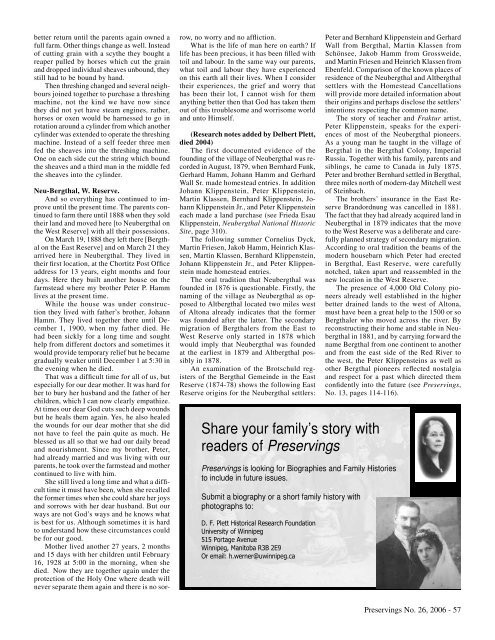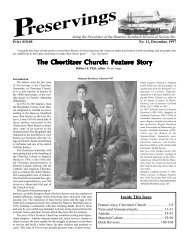Preservings $20 Issue No. 26, 2006 - Home at Plett Foundation
Preservings $20 Issue No. 26, 2006 - Home at Plett Foundation
Preservings $20 Issue No. 26, 2006 - Home at Plett Foundation
You also want an ePaper? Increase the reach of your titles
YUMPU automatically turns print PDFs into web optimized ePapers that Google loves.
etter return until the parents again owned a<br />
full farm. Other things change as well. Instead<br />
of cutting grain with a scythe they bought a<br />
reaper pulled by horses which cut the grain<br />
and dropped individual sheaves unbound, they<br />
still had to be bound by hand.<br />
Then threshing changed and several neighbours<br />
joined together to purchase a threshing<br />
machine, not the kind we have now since<br />
they did not yet have steam engines, r<strong>at</strong>her,<br />
horses or oxen would be harnessed to go in<br />
rot<strong>at</strong>ion around a cylinder from which another<br />
cylinder was extended to oper<strong>at</strong>e the threshing<br />
machine. Instead of a self feeder three men<br />
fed the sheaves into the threshing machine.<br />
One on each side cut the string which bound<br />
the sheaves and a third man in the middle fed<br />
the sheaves into the cylinder.<br />
Neu-Bergthal, W. Reserve.<br />
And so everything has continued to improve<br />
until the present time. The parents continued<br />
to farm there until 1888 when they sold<br />
their land and moved here [to Neubergthal on<br />
the West Reserve] with all their possessions.<br />
On March 19, 1888 they left there [Bergthal<br />
on the East Reserve] and on March 21 they<br />
arrived here in Neubergthal. They lived in<br />
their first loc<strong>at</strong>ion, <strong>at</strong> the Chortitz Post Office<br />
address for 13 years, eight months and four<br />
days. Here they built another house on the<br />
farmstead where my brother Peter P. Hamm<br />
lives <strong>at</strong> the present time.<br />
While the house was under construction<br />
they lived with f<strong>at</strong>her’s brother, Johann<br />
Hamm. They lived together there until December<br />
1, 1900, when my f<strong>at</strong>her died. He<br />
had been sickly for a long time and sought<br />
help from different doctors and sometimes it<br />
would provide temporary relief but he became<br />
gradually weaker until December 1 <strong>at</strong> 5:30 in<br />
the evening when he died.<br />
Th<strong>at</strong> was a difficult time for all of us, but<br />
especially for our dear mother. It was hard for<br />
her to bury her husband and the f<strong>at</strong>her of her<br />
children, which I can now clearly emp<strong>at</strong>hize.<br />
At times our dear God cuts such deep wounds<br />
but he heals them again. Yes, he also healed<br />
the wounds for our dear mother th<strong>at</strong> she did<br />
not have to feel the pain quite as much. He<br />
blessed us all so th<strong>at</strong> we had our daily bread<br />
and nourishment. Since my brother, Peter,<br />
had already married and was living with our<br />
parents, he took over the farmstead and mother<br />
continued to live with him.<br />
She still lived a long time and wh<strong>at</strong> a difficult<br />
time it must have been, when she recalled<br />
the former times when she could share her joys<br />
and sorrows with her dear husband. But our<br />
ways are not God’s ways and he knows wh<strong>at</strong><br />
is best for us. Although sometimes it is hard<br />
to understand how these circumstances could<br />
be for our good.<br />
Mother lived another 27 years, 2 months<br />
and 15 days with her children until February<br />
16, 1928 <strong>at</strong> 5:00 in the morning, when she<br />
died. <strong>No</strong>w they are together again under the<br />
protection of the Holy One where de<strong>at</strong>h will<br />
never separ<strong>at</strong>e them again and there is no sorrow,<br />
no worry and no affliction.<br />
Wh<strong>at</strong> is the life of man here on earth? If<br />
life has been precious, it has been filled with<br />
toil and labour. In the same way our parents,<br />
wh<strong>at</strong> toil and labour they have experienced<br />
on this earth all their lives. When I consider<br />
their experiences, the grief and worry th<strong>at</strong><br />
has been their lot, I cannot wish for them<br />
anything better then th<strong>at</strong> God has taken them<br />
out of this troublesome and worrisome world<br />
and unto Himself.<br />
(Research notes added by Delbert <strong>Plett</strong>,<br />
died 2004)<br />
The first documented evidence of the<br />
founding of the village of Neubergthal was recorded<br />
in August, 1879, when Bernhard Funk,<br />
Gerhard Hamm, Johann Hamm and Gerhard<br />
Wall Sr. made homestead entries. In addition<br />
Johann Klippenstein, Peter Klippenstein,<br />
Martin Klassen, Bernhard Klippenstein, Johann<br />
Klippenstein Jr., and Peter Klippenstein<br />
each made a land purchase (see Frieda Esau<br />
Klippenstein, Neubergthal N<strong>at</strong>ional Historic<br />
Site, page 310).<br />
The following summer Cornelius Dyck,<br />
Martin Friesen, Jakob Hamm, Heinrich Klassen,<br />
Martin Klassen, Bernhard Klippenstein,<br />
Johann Klippenstein Jr., and Peter Klippenstein<br />
made homestead entries.<br />
The oral tradition th<strong>at</strong> Neubergthal was<br />
founded in 1876 is questionable. Firstly, the<br />
naming of the village as Neubergthal as opposed<br />
to Altbergthal loc<strong>at</strong>ed two miles west<br />
of Altona already indic<strong>at</strong>es th<strong>at</strong> the former<br />
was founded after the l<strong>at</strong>ter. The secondary<br />
migr<strong>at</strong>ion of Bergthalers from the East to<br />
West Reserve only started in 1878 which<br />
would imply th<strong>at</strong> Neubergthal was founded<br />
<strong>at</strong> the earliest in 1879 and Altbergthal possibly<br />
in 1878.<br />
An examin<strong>at</strong>ion of the Brotschuld registers<br />
of the Bergthal Gemeinde in the East<br />
Reserve (1874-78) shows the following East<br />
Reserve origins for the Neubergthal settlers:<br />
Share your family’s story with<br />
readers of <strong>Preservings</strong><br />
Peter and Bernhard Klippenstein and Gerhard<br />
Wall from Bergthal, Martin Klassen from<br />
Schönsee, Jakob Hamm from Grossweide,<br />
and Martin Friesen and Heinrich Klassen from<br />
Ebenfeld. Comparison of the known places of<br />
residence of the Neubergthal and Altbergthal<br />
settlers with the <strong>Home</strong>stead Cancell<strong>at</strong>ions<br />
will provide more detailed inform<strong>at</strong>ion about<br />
their origins and perhaps disclose the settlers’<br />
intentions respecting the common name.<br />
The story of teacher and Fraktur artist,<br />
Peter Klippenstein, speaks for the experiences<br />
of most of the Neubergthal pioneers.<br />
As a young man he taught in the village of<br />
Bergthal in the Bergthal Colony, Imperial<br />
Russia. Together with his family, parents and<br />
siblings, he came to Canada in July 1875.<br />
Peter and brother Bernhard settled in Bergthal,<br />
three miles north of modern-day Mitchell west<br />
of Steinbach.<br />
The brothers’ insurance in the East Reserve<br />
Brandordnung was cancelled in 1881.<br />
The fact th<strong>at</strong> they had already acquired land in<br />
Neubergthal in 1879 indic<strong>at</strong>es th<strong>at</strong> the move<br />
to the West Reserve was a deliber<strong>at</strong>e and carefully<br />
planned str<strong>at</strong>egy of secondary migr<strong>at</strong>ion.<br />
According to oral tradition the beams of the<br />
modern housebarn which Peter had erected<br />
in Bergthal, East Reserve, were carefully<br />
notched, taken apart and reassembled in the<br />
new loc<strong>at</strong>ion in the West Reserve.<br />
The presence of 4,000 Old Colony pioneers<br />
already well established in the higher<br />
better drained lands to the west of Altona,<br />
must have been a gre<strong>at</strong> help to the 1500 or so<br />
Bergthaler who moved across the river. By<br />
reconstructing their home and stable in Neubergthal<br />
in 1881, and by carrying forward the<br />
name Bergthal from one continent to another<br />
and from the east side of the Red River to<br />
the west, the Peter Klippensteins as well as<br />
other Bergthal pioneers reflected nostalgia<br />
and respect for a past which directed them<br />
confidently into the future (see <strong>Preservings</strong>,<br />
<strong>No</strong>. 13, pages 114-116).<br />
<strong>Preservings</strong> is looking for Biographies and Family Histories<br />
to include in future issues.<br />
Submit a biography or a short family history with<br />
photographs to:<br />
<br />
<br />
<br />
<br />
<br />
<strong>Preservings</strong> <strong>No</strong>. <strong>26</strong>, <strong>2006</strong> - 57
















